| Industrially Produced Zithers Without Fingerboards |
| Andreas Michel |
| Changes in Central European Concepts of Folk Musical Instruments |
| Social developments in late 19th-century Europe and changes in that continent's cultural an economic life led to transformed conditions in the musical life of the lower
social classes. The democratization of petit bourgeoisie and proletarian cultural life and the aspiration of those
classes for their own forms of culture had numerous consequences that greatly affected musical life. Objects of
bourgeois education, until then only available to the upper classes, penetrated increasingly into the culture of the
general folk and were partially assimilated. General education in the schools as well as educational associations for
adults experienced an upswing that had been unknown until then. In this climate, the transmitted forms of customary
music-making had to undergo change. These changes were produced from the concurrence of numerous factors, of which two
will serve here as a point of departure for our description of a new development in musical instrument construction and
use:
1. the industrially manufacture of musical instruments and
2. the concept – or construct – of "folk music instrument" at the beginning of the 20th century in central Europe. Both aspects, the economic and the ideological,
form in their mutual dependence the basis for the emergence of a new form of music-making practice and of a specific
understanding of folk music that changed earlier conceptualizations. |
| The general rise of large-scale industrial
production during the second half of the 19th century also extended to the manufacture of musical
instruments. This mass production of instruments, which already had taken place since the 18th century in
factories particularly in England, at first fulfilled the same functions as traditional musical instrument construction. |
 |
The functional cycle represented in fig. 1 reflects the whole system of musical instrument development (Heyde 1979, 49f.; Michel 1990, 4-9). In this, musical
instrument construction is a mediator between the determinants of the whole system, which include the elements: musical
praxis, "postulate" (meaning all expectations and demands related to sound and playing technique), technical realization
of the postulate and sound reality. These elements form a circulatory cycle, in which musical instrument construction
acts as producer and in a mediating way. |
| Fig. 1: Functional cycle of musical instrument development (cf. Heyde 1979, 49f.) |
|
At first industrial instrument construction fulfilled the same mediating function as traditional instrument construction. Industrial manufacture led simply to a
quantitative change: the increase in instruments produced served a larger target group of interested persons. However,
as soon as the industrial manufacture of musical instruments began, the traditional circle of function began to change,
since industrial production I tied to its own set of laws that are not determined by the product itself. As is well
known, this stems from the fact that industrial production requires steady and increasing sales. In order to guarantee
these, a mechanism is necessary that is today called marketing. New forms of distribution and sales cause the increasing
separation of manufacturer and musician-player. Their contact takes place more and more trough tradesmen and
distribution companies, whereby the printed instrument catalogue takes on an important function. The musical instrument
as product is subjected to a distribution mechanism determined by its owns laws and a sales strategy. These aim towards:
1. The enlargement of the target group, thus of potential buyers;
2. mass distribution; and
3. ensuring continuing new sales through innovations.
|
| These three aspects of capitalistic industrial production marked the development of musical instruments at the end of the 19th century in an essential way. A
particular group of "newly discovered" chordophones can be understood, more than any other type of instrument of this
period, as a part and result of this process: zithers without fingerboards. During a period of approximately fifty years
– until around the 1940s – zithers without fingerboards were a significant phenomenon in industrially construction and
represent an exemplary model case. |
| Zithers Without Fingerboards: The Instruments |
| The modern European zither, which developed from the Scheitholt zither and adopted characteristics
of the cittern and the guitar, is generally a fingerboard zither. As such, by the mid-19th century it had reached a
certain level of musical-historical significance and integration in contemporary central European musical life. The
development of the zither without fingerboard, which is related to the late-medieval psaltery, constitutes both
morphologically as well as music-culturally an independent development. |
| In the course of the already mentioned petit bourgeois and proletarian aspirations toward
democracy in musical life from the last quarter of the 19zh century, the demand arose in many places for simple, cheap,
and multifaceted folk music instruments that could be easily learned – if possible, without knowledge of score reading.
The model for this "folk music culture" was provided by bourgeois education: the model and point of departure for folk
culture was not tradition but rather the next higher social class towards which the people aspired. (We must leave
discussion of the causes of proletarian cultural life becoming bourgeois for elsewhere.) |
| As is revealed in sales figures, the musical instrument industry served mass interests with
innumerable inventions, new developments and in some cases with experiments that had not been thoroughly thought out.
Many curiosities were offered with great fanfare. |
| The idea of making a zither without fingerboard available for leisure activities involving folk
music can be regarded in this context. Its "inventors" followed diverse paths, which can be ordered from a systematic
viewpoint in the following way: |
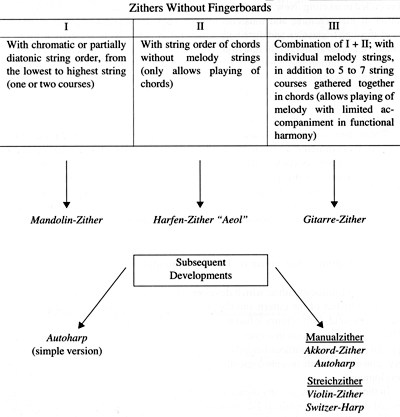 |
1. Zithers without fingerboards having a chromatic or partially
diatonic string order from the lowest to the highest string (one- or two-course); these instruments can play simple
melodies or, with the additional help of grip and key fittings as on the autoharp, chords (see below);
2. Zithers without fingerboards having the string order of chords;
on these instruments, five to eight strings are gathered in each course, which are tuned to sound in three voices.
Several three-voiced chords enable one to play simple chord progressions in functional harmony, being originally so
tuned. The instrument is not meant for playing melodies (see Inv.-No. 4151).
3. Combination of 1) and 2); thus, an instrument with individual
melodic strings covering two or three octaves, within which five to seven strings are gathered together into groups
arranged in chords. This instrument provides simultaneous, limited accompaniment in functional harmony to the playing of
melodies. |
| Fig. 2: Classification of zithers without fingerboards |
|
| The names given to these models – often these are good-sounding labels for advertising purposes –
sometimes seem confusing and misleading. Most of the names can be traced to the roots of Harfen-Zither and Gitarre(n)-Zither.
Additional variants are: Mandolin-Gitarr-Zither and Mandolinen-Harfen-Zither (for instruments with double-course
strings), Konzert-Gitarren-Zither, Salonharfe, Sonora-Zither (an advertising name), etc. The names were not invented in any logical way but rather were expected to create sound
associations which could, however, hardly be realized in reality. From a systematic point of view, the closest
designation of Akkordzither (chord zither) as a generic term should also be avoided, for it is applied to zithers,
without fingerboards but having key manuals. |
 |
Fig. 3a
Gitarrenzither
Menzenhauer & Schmidt, Berlin, um 1910
Signature: "Menzenhauers Guitar-Zither / 3½ ORIGINAL 3½ / Menzenhauer & Schmidt. Berlin"
49 strings, 25 melody strings, 6 chords (6 x 4 strings)
Leipzig, Museum of Musical Instruments of the University of Leipzig, Inv.-No. 4508 |
 |
Fig. 3b
Gitarrenzither
Menzenhauer & Schmidt, Berlin, um 1910
Signature: "F. MENZENHAUER'S / GUITAR-ZITHER / No. 2½ / D.G.M.P. No. 168.664 / Fabricirt von / MENZENHAUER & SCHMIDT / BERLIN - NEW YORK"
41 strings, 25 melody strings; 6 chords (6 x 4 strings)
Leipzig, Museum of Musical Instruments of the University of Leipzig, Inv.-No. 4289
|
 |
Fig. 4
Violin-Zither
Max Lausmann, Klingenthal, around 1930
Signatures : "Konzert-Violin-Harfe / Max Lausmann / Musikinstrumente aller Art / Klingenthal i. Sa." (on label); "Suitzer-Harp" (writing on upper surface)
18 melody strings in two rows (c' ... f'''), diatonic; 5 chords (5 x 7 strings)
Leipzig, Museum of Musical Instruments of the University of Leipzig, Inv.-No. 4715
|
 |
Fig. 5
Manualzither
Paul Thierfeld, Johanngeorgenstadt, around 1910
Signatures (engraving on the cover surface of the manual box): "Thierfeld's / Accordzither" and "Mignon" (celluloid label on the side facing the back of the manual box); ; "D.R.G.M. 70378"
32 strings (G ... c''')
Leipzig, Museum of Musical Instruments of the University of Leipzig, Inv.-No. 3952 |
|
| Zither instruments without fretboard were designated Gitarrenzither (see fig. 3, 6, 9-11) and were
played in the traditional way for a zither, with fingers and a thumb plectrum. In terms of construction, these zithers
have little in common with the guitar; the designation refers more to the sound it produced, which is typical of chord
playing on the guitar. In addition to the melody strings, which usually cover three octaves and are chromatically tuned
(c' – c'''), there are 24 to 30 accompanying strings gathered together in five or six chords (e.g. e-minor – A-major –
D-major – F-major – G-major – C-major). In 1894 a Gitarr-Zither was patented by Friedrich Menzenhauer of Berlin which was manufactured by the company Oscar
Schmidt ("Menzenhauer & Schmidt") in Berlin but also increasingly in New Jersey (U.S.A.). |
|
| Beginning in 1894, the company founded by Oscar Schmidt in 1879 produced others the guitar-zither of Friedrich Menzenhauer. Around 1900 production was increasingly
transferred, however, to Jersey City (New Jersey, U.S.A.), where these instruments (autoharps) are still manufactured today. The factory existed from 1901 under the name "United
States Guitar Zither Co. Friedrich Menzenhauer & C." (the owner was Oscar Schmidt in Berlin, Bonn and Jersey City.
For a time the company name was also "Menzenhauer & Schmidt". In 1901 the Berlin factory employed 31 workers and the factory in New Jersey many more than
this (cf. de Wit 1912, 67 and 1926, 115; Heyde 1994, 229f.) |
|
|
| The Harfen-Zithern (fig. 11), distributed also by a German-American concern, reduced musical demands to an even lower
degree. This zither instrument, distributed by the German representative of the Aeolian Company of New York, Alwin Eichler in Berlin,
dispensed entirely with melody strings and was made purely as an accompanying instrument, with five or six chords (D.R.P. 101661 of 3 September 1897:
Alwin Eichler zither string order in chordal groups; cf. Wackernagel 1997, 148). |
| In spite of the vehement and understandable rejection of these instruments by traditional zither players, the guitar zithers enjoyed wide distribution. In addition,
they were subjected to numerous modifications and "improvements", such as their development to a Mandolin-Gitarr-Zither
through the doubling of melody strings, according to the mandolin model. Max Kleiber of Markneukirchen patented in 1900
a lyre zither, a "guitar zither with two harp buttons joined by columns" (D.R.G.M. 130447 of 27 February 1900; cf. Heyde
1989, 15). The name derives from the form, which was supposedly reminiscent of the lyre. |
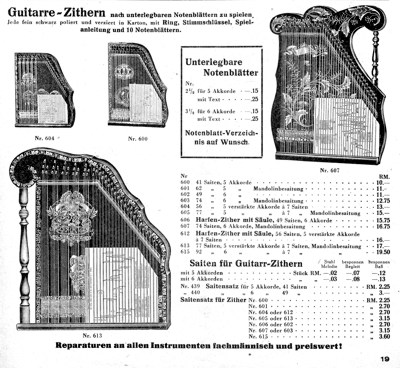 |
Until the late 1930s, trade and catalogue companies in Markneukirchen and Klingenthal (both cities
in the present-day German state of Sachsen) offered a wide palette of such guitar zithers.
The instruments were manufactured in great numbers. The design of the instruments was carried out
in an empirical way, not simply on a theoretical basis. As a rule, the body was stained and lacquered black, as well as
decorated with richly coloured transfer illustrations or with ornamentation in coloured ink. |
Sales catalogue of the company Edmund Paulus, Markneukirchen um 1930, p. 19
cf.: Sales catalogue no. 70. of the trading company Gebrüder Schuster, Markneukirchen ca. 1925, pp. 128f.; sales catalogue of the company Ernst Hess Nachf.,
Klingenthal ca 1937, pp. 47f.; sales catalogue no. XXXV of the trading company Meinel
& Herold, Klingenthal ca. 1938, pp. 66-70 |
|
| The autoharp (see fig. 5) – in its original form a zither without fingerboard having a "Manualaufsatz"
(manual box) or a "Abgreifeinrichtung" (damper bass controlled by keys) – was patented in 1882 in the United States. It is considered an
invention of Carl Friedrich Zimmermann, who had immigrated from Germany in 1864. In Germany such instruments were built by Theodor Meinhold in Klingenthal,
Paul Thierfeld in Johanngeorgenstadt and the Müller Company, among others (cf. D.R.G.M.
70378 and 80599). |
| The instruments that became widespread during the 20th century under the names Violin-Zither and
Violin-Harfe can also be considered special forms of
fingerboardless zither. In 1925 the Clemens Neuber Company of Klingenthal received a designation of "Gebrauchsmusterschutz"
("German Registered Design") for a newly developed so called violin zither (D.R.G.M. No. 903152). A violin zither with
the name "Kalliope" from the trading firm C. A. Wunderlich, Siebenbrunn (Vogtland, central Germany) carried the D.R.G.M. No. 973507. |
| The instruments combine characteristics of the guitar zither without fingerboard, but also with the possibility of stroking individual strings. A short violin bow,
only about 55 cm in length and used with the right hand, is used to play the melody strings. The (usually) 18 diatonically tuned strings used for playing the melody are of different length, so that each can also be played
individually at a particular place in the music. The strings for accompanying the melody are arranged in five or six chords, thus allowing simple song accompaniment in functional harmony. The
Konzert-Violin-Harfe is a variant of the
violin zither built by Max Lausmann of Klingenthal (Reinbothe 1987, 7). |
| Playing Technique |
| At first glance, zithers without fingerboards seem to offer an important advantage in playing
technique: the plucking of strings and the tedious process of learning the stopping technique for the left hand are no
longer necessary. However, viewed in terms of its historical development, the dispensing of a fingerboard with
frets and the expansion of the number of strings (one note per string) together represent in reality a step backwards.
For in the history of chordophones it is particularly the reduction of playing strings and the possibility of shortening
strings by pressing them down on a fretboard that must be evaluated as a thrust forward in development and as offering
more quality to technical playing, as well as musical, possibilities. The zither without fingerboard, on the other hand,
represents a step in the other direction. The apparent advantage of dispensing with stopping techniques must be
compensated by the more difficult mastery of striking a much larger number of strings. |
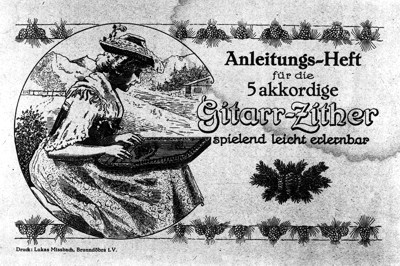 |
|
| Fig. 7: Titel page of "Instruction Booklet for the Five-chord Guitar Zither", Markneukirchen, um 1910 |
|
| In order to solve this problem both in terms of practical playing and of notation, a special
notation system was applied. This notation system, or better, playing aid, was to function without the traditional
notational forms in order to also enable those who could not read musical scores to play. In 1891 Theodor Meinhold of
Klingenthal invented the so-called " Unterlegblätter" ("underlying sheets"). These "underlying sheets" contain diagrams
that are placed over the body of the instrument and underneath the strings. The patent application describes the
instructions fro use as follows (see ZfI XIII, 1892, 199): |
| "Zither with score sheets arranged under the strings. Theo. Meinhold in Klingenthal,
Sachsen – No. 63702 from 13 October 1891. (Addition to Patent No. 60200 of 30 April 1891.) The score
sheet is pushed between two ridges under the strings and is provided with written notes which are so arranged that, when
the score sheet is placed in the correct location, it lies under the appropriate strings in order as they are to be
played in the notation." |
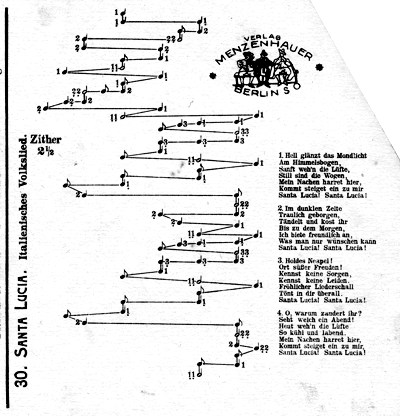 |
The principle of notation is identical: the progression of the melody is represented as a curve
that shows, at places marked by notes, where the strings are to be pressed. The accompanying chords are marked with
numbers that appear next to each notehead.
The numbers mean:
| - |
plain number |
only bass string |
| - |
number with dot underneath |
chord without bass string |
| - |
number with curve underneath |
full chord with bass string |
|
| Fig. 8: "Underlying sheet" for guitar zither. Verlag Menzenhauer, Berlin, around 1900 |
|
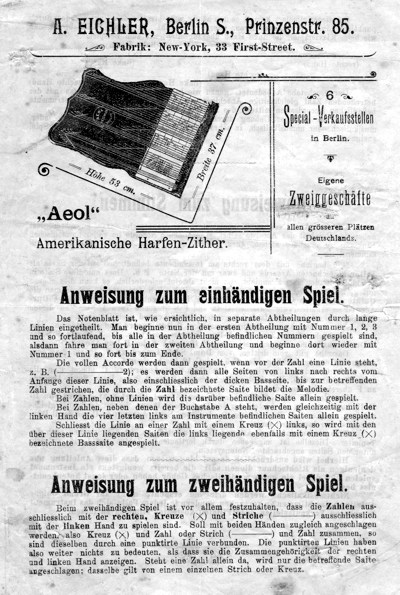 |
The playing instructions for the American harp-zither "Aeol" made by the Alwin Eichler Company of Berlin are underlaid
by a somewhat different system (fig. 11). In this system, the chords to be strummed are marked by crosses (X) and lines
(-). All in all, these notational process thus contain information on melodic progression (to the order of notes), the
string to be stroked, the length of pitches as well as the three different ways of setting the strings in motion in the
chordal accompaniment. When one also considers that these notations lie underneath the strings, it becomes quit clear
that "sheet playing" is for all practical purposes excluded. The use of "underlying sheets" demands a longer period of
practice and should be understood more as a learning aid. In addition, for the majority of players the multi-layered
working out of the notation only becomes accessible when they already know the musical piece. From the existing
"underlying sheets" we can see that they went back, almost without exception, to popular songs widespread among the
common people. Purely instrumental pieces, such as for example "Menzenhausers Guitar-Zither Mazurka" could be seen as
the exception (recorded in the CD Der Zitherhändler, performed by Lorenz Mühlemann, Paolo Imola and Fabian Müller,
Mülirad CD/MC 4001, Zürich 1993). |
| Fig. 11: Playing instructions for the "Amerikanische Harfen-Zither Aeol" by Alwin Eichler,
around 1905 |
|
| In order to promote learning of the guitar-zither, courses were organized and classes formed.
Often the recommendation to visit such a course of instruction was made immediately at the time of sale (see for example
the contract for courses of the Berne music teacher Leo Prêtre from the year 1933, reproduced in Mühlemann 1993, 14). |
| Sales and Advertising Strategy |
| In 1904 the Zeitschrift für Instrumentenbau informed in a report "On the Situation of the Musical Instrument Industry in Berlin in the Year 1903"
that "the
instruments with scores that can be laid underneath the strings, introduced already since a number of years and also
manufactured now in Berlin, still enjoy a good level of acceptance, particularly the so-called guitar-zither" (ZfI XXIV,
1904, 519). This sales success must have been above all the result of a well-aimed and energetic sales strategy and
advertising campaign. How was the sale of the guitar-zither advertised? |
| The most important and repeatedly raised argument for the zither without finderboard was the promise to be able to play a musical instrument without instruction
or practice: "Without any kind of knowledge of notation, you will definitely be able to play the most beautiful songs,
marches and dances within one hour" (see sales catalogue no. XXXV of the trading firm Meinel & Herold, Klingenthal
around 1938, p. 67). The blatantly misleading time period that is repeatedly asserted ("within on hour") must certainly
have been a mistaken estimate of large proportions and one with frequently disastrous consequences for the disappointed
buyer. As already mentioned, it is indeed possible that the notational principle of underlying sheets can be quickly
understood, but on the other hand the effort needed to acquire plying skill does not differ greatly (or is only slightly
less) than the effort needed on other kinds of instruments. |
| Ideological reasons were given for the distribution of the guitar-zither: according to manufactures and dealers, the instrument, seemingly so simple to play,
fulfilled demands for a folk instrument. The concept "Volk" attempts to define the social boundaries, and the concept "Volksmusik"
is thereby suggested. Both were to ensure an identify for the instrument. In the sales catalogue no. XXXV of Meinel &
Herold, around 1938, we can read (see fig. 6): "The guitar-zither is, rightly so, the folk zither of the future and
should not be lacking in any household! Thousands of different kinds of sheet music have appeared and all new
publications in the area of music are transferred to underlying music sheets. You can always have the latest hits for
guitar-zither". Mass production was to lead to a cultural identity. The capitalistic marketing principle had completely
taken over the musical instrument industry. It was not demand that created the product, but rather demand for the
product had to be won. |
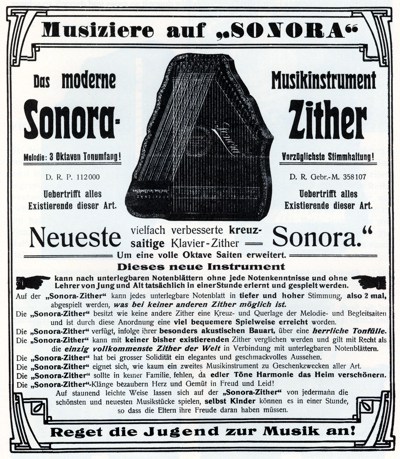 |
The advertising appears correspondingly shrill and sometimes even contains lies. The advertising texts – in the style of an ad for detergent – was to make clear: there
is in fact no favourable quality that this instrument does not posses. A striking example of almost propagandistic
advertising is represented by a text for a variant of the guitar-zither with crosses strings with the name "Sonora" (see fig. 10). In
addition to the description of the merits and improvements of the instrument in contrast to other models, it is claimed:
- The Sonora Zither has available to it, because of its specials acoustic manner of construction, a wonderful fullness of tone.
- The Sonora Zither cannot be compared with another other zither existing up to now and is considered, rightly so, the only perfect zither in the world in connection with underlying sheet music.
- The Sonora Zither has, with its great solidity, an elegant and tasteful appearance.
- The Sonora Zither is appropriate as scarcely any other musical instrument for the purposes of gift-giving of all kinds.
- The sounds of the Sonora Zither entrance heart and soul in joy and sorrow! |
| Fig. 10: Advertising leaflet for the guitar-zither "Sonora", around 1910 (cf. Mühlemann 1993, 11) |
|
| This massive advertising was complemented by the
outer design of the instrument which, with highly polished lacquer and bright transfer illustrations, gave the
appearance of being of high value. In this way – and the reference to "gift-giving of all kinds" underlines this
particularly – the instrument is made into an object of extra-musical significance. Aesthetic appearance determines the
cultural value. |
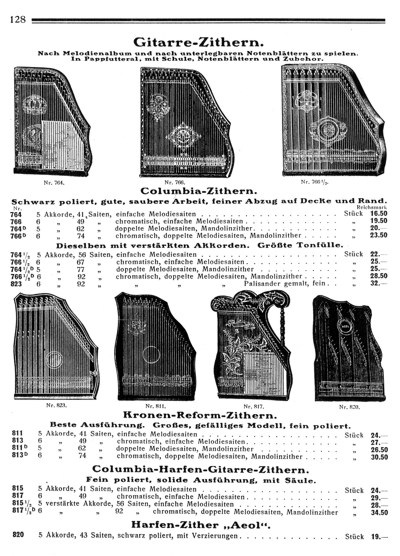 |
Mass production also made possible a low sales price. From the beginning the manufacture of guitar-zithers ignored the carefulness and criteria of quality of classical
zither construction. A glance at the sales prices listed in the catalogues makes this clear.
The sales catalogue no. 70. of the trading firm Gebrüder Schuster in Markneukirchen (around 1925, p. 120-129) displays ten models of traditional fingerboard zithers
(concert zither, "Perfektazithern", "Luftresonanzzithern", etc.) in altogether 26 variations and seven models of
fingerboardless zithers (guitar-zithers, chord-zithers, harp-zithers, etc.) The following
overview statistics reflect the lowest and highest prices respectively, as well as the average sales price. Even
when one considers that fingerboards and geared tuning mechanism for the fingerboard strings raise the manufacturing
costs of concert zithers, the price gap between the two groups of instruments – the classical zither models are on the
average 5 1/2 times more expensive – is quite conspicuous. The most expensive guitar zither – a so called "Columbia harp-guitar-zither" with 92 strings, double-coursed melody strings and six chords – cost 34.50 Reichsmarks, and thus
only a bit more than cheapest concert zither. |
| Sales catalogue no. 70 of the trading firm Gebrüder Schuster in Markneukirchen, p. 128, from around
1925 |
|
| Fig. 12: Fingerboard and fingerboardless zithers - sale prices (around 1925), figures taken from sales
catalogue no. 70 of the trading firm Gebrüder Schuster in Markneukirchen, p. 120-129, from around 1925 |
| |
| |
Price range |
Average price |
| Fingerboard zithers |
26.00 … 430.00 RM |
128.20 RM |
| Fingerboardless zithers |
9.80 … 68.00 RM |
24.70 RM |
|
|
| Through massive advertising, cheap production costs and low sales prices, enormous sales resulted for the zithers without fingerboard. Sales during the height of
their popularity can be estimated worldwide at about 500,000 instruments per year. The mass production of the newly
developed fingerboardless zithers began in the 1890s and reached its height, according to manufacturers' statistics,
around the turn of the century. From then production increased steadily but inconsiderably, with only a slight decline
during the First World War. During the 1920s and 30s, the instruments belonged to the standard offering of all musical
instrument stores, and because of their low price, many instruments continued to be sold. The Second World War triggered
a collapse of the musical instrument industry due to the elimination of the export market, causing sales to fall
drastically. The new begin in musical life after the war signified at the same time a remembering of the original folk
music instruments (fingerboard zithers), and since the 1950s the guitar has asserted itself as the dominant instrument. |
| Effect on Musical Practice |
| Considering the millions of sales of this type of musical instrument, the conclusion that we may speak here of a "popular instrument" seems justified. The level of
recognition of zithers without fingerboard continues to this day; for many amateurs, it is still the superlative
representative of zithers. Those who, as employees of a musical instrument museum, are involved with sales offerings
from the public will quickly experience this firsthand. |
| Still, one must also approach with scepticism
the question of whether zithers without fingerboards are also therefore "folk"(musical) instruments." By analyzing forms
of musical acquisition by the procurers of fingerboardless zithers, the following can be established: |
1. The didactic value of the instrument consists of annotation form, in principle uncomplicated and self-learnable, and that form's realization. The "underlying sheets"
seem to be in fact useful: the autodidact can learn the progression of a known melody. (What is not accomplished is the
short period of learning promised in the advertising materials. What can be understood within one hour is the principle
that manual dexterity must be learned.) It thus remains open whether mass sales of the instrument led also to equivalent
music-making. The thesis that there is no substitute for the transmitted learning of a musical instrument – regardless
of folk or art music – is strengthened. In the West, the idea of a universal chordophone that can be learned quickly and
without effort remains fiction. Only the chord zither fulfils the promise of a quick-to-learn musical instrument. This
instrument attained a certain importance in the pedagogical field, particularly in the United States,
as a simple instrument for song accompaniment.
2. In contrast to the enormous sales, a very
humble degree of success in musical practice emerged. At any rate, the instruments disappeared at the latest in the
1940s from sales offerings. In the long run, they could not offer any real competition to the traditional fingerboard
zither (or other musical instruments. for that matter). The players of fingerboard zithers actually disdain the
instrument without fingerboard. The pejorative evaluation of Josef Brandlmeier
in the Handbuch der Zither is symptomatic of this attitude: "We frequently encounter further, above all in northern
Germany, still another zither with the mark 'Akkordzither' or also 'Gitarren-Zither'; by this is meant however a musical
instrument which is not be taken seriously but which is a musical toy, not completely without spirit (psalter type).
Included here is also the so called 'Violinzither', a meaningless expression for an instrument, which is praised as a
'substitute' for the violin and which can be played as the types mentioned above with underlying score rolls" (Brandlmeier
1963, 297). Guitar- and chord-zithers no longer play a role in concert life or in other forms of public musical
performance in Germany.
3. A specific and individual repertoire that
corresponds to the idiom of the instrument was never created. Transcription was the common means of repertoire
formation. As in other new developments of logically thought-out instruments, such as the Stössel-Laute, the conception
hindered to a large degree virtuosic playing technique.
4. Still, the invention of the zithers without
fingerboards also had positive consequences for the broad musical culture in the 20th century. The sound of
the instrument has entered, to a limited degree, the corpus of folk and popular music in the largest sense. As a result
of nostalgia and intentions of revival, a small group of specialists has emerged which uses these instruments and
occasionally develops an individual playing technique on them (see Lieser 1985, 31f.; Mühlemann 1993, 34f.). |
| Abbreviations: D.R.P. = Deutsches Reichspatent (German Patent; from 1877); D.R.G.M. = Deutsches
Reichsgebrauchsmuster (German Registered Design); ZfI = Zeitschrift für Instrumentenbau (Journal for Instrument
Construction; from 1880); RM = Reichsmark (the Reichsmark monetary currency was used in Germany between 1924 and 1948) |
| first published in: the world of music, Vol. 39/3 (1997), pp. 71-90 |
|
Table of Contents |
Zithern: Collection |
Bibliography |
| © STUDIA INSTRUMENTORUM MUSICAE 2001 |











